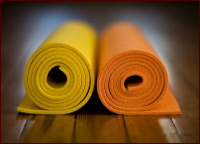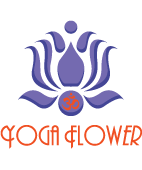Yoga zweverig?! (English below)
Als je bij het woord Yoga denkt aan magere mannen met grijze baarden die ‘hoppend’ door het leven gaan en geitenwollensokken-zweefclubjes dan kom je bedrogen uit!
Yoga is hip en populairder dan ooit! De sterren ‘doen’ het, de bladen staan er vol van en de fancy yogastudio’s schieten al jarenlang als paddenstoelen uit de grond.
Dit heeft alles te maken met de steeds sneller wordende maatschappij waarin iedereen van alles moet en wil bereiken en waar innerlijke balans ver te zoeken is. Die innerlijke balans kan yoga bieden.
De wetenschap en beoefening van Yoga is eeuwenoud en afkomstig uit India. Yoga is altijd al veel beoefend maar had voor veel mensen een zweverig imago. In voor ‘het westen’ toegankelijk gemaakte yogastijlen is yoga van de zweem van vaagheid ontdaan.
Met Yoga werk je aan een soepel en sterk lijf en kom je tegelijkertijd geestelijk beter in balans. Je komt stevig met je voeten op de grond te staan. Bij Yoga gaat het er niet om dat je je lijf in ingewikkelde bochten moet kunnen wringen (wat overigens wel heel leuk is om te proberen!). Waar het vooral om gaat is dat je bewuster wordt van je beperkingen en de wijze waarop je daarmee omgaat. Niet alleen op de yogamat maar ook in het dagelijks leven. Raak je bijvoorbeeld volledig gefrustreerd als iets niet meteen lukt of accepteer je de situatie en probeer je rustig verder te komen? Of heb je verwachtingen van iets of iemand en ben je teleurgesteld als deze verwachtingen niet uitkomen of accepteer je de situatie zoals deze is en blijf je bij jezelf?
Hatha Yoga
Het woord Yoga komt uit het Sanskriet en betekent letterlijk ‘verenigen’ of ‘verbinden. Hatha Yoga is wat de meeste mensen in de westerse wereld associeren met het woord ‘Yoga’. Dit is de fysieke vorm van Yoga waarin lichaamshoudingen (asana’s) en ademhalingsoefeningen (pranayama) centraal staan. Door het beoefenen van asana’s in combinatie met een bewuste ademhaling kun je je fysiek en mentaal ontspannen en kom je meer in balans. Er ontstaat een ‘verbinding’ tussen je lichaam en je geest.
Door helemaal op te gaan in de oefeningen vergeet je te piekeren over je dagelijkse zorgen en bezigheden. Het helpt pijn, stress en frustraties op te lossen en je voelt je daardoor rustiger.
Yoga kan beoefend worden door iedereen en je hoeft niet per definitie fit of lenig te zijn. Gunstige effecten van Yoga zijn:
– soepelheid en flexibiliteit
– sterke spieren en gewrichten
– verbeterde lichaamshouding: versterkt rug, buikspieren, benen
– energieverhogend
– verbeterde ademhaling
– verbeterde doorbloeding
– zenuwstelsel komt tot rust
– evenwicht van de stofwisseling en hormoonhuishouding
Om echt te weten te komen wat Yoga inhoudt moet je het zelf ervaren!
Vinyasa Yoga
Vinyasa Yoga is een vorm van Hatha Yoga. Vinyasa betekent ‘flow’ of ‘een op de adem gesynchroniseerde beweging’. Het is een krachtige en dynamische vorm van Hatha Yoga gebaseerd op de uitvoering van een serie houdingen genaamd ‘de zonnegroet’ (surya namaskara). Het lichaam beweegt op de adem van de ene houding in de andere.
Yoga airy fairy?!
 When you think of yoga what images come to mind? You might associate it with skinny bearded men hopping around in a lotus position…or airy fairy women in wide dresses chanting mantra’s. Well…you might be ‘disappointed’ to hear that yoga is more popular than ever! In a lot of cities you can find a yoga studio on almost every street corner, the magazines write about yoga, athletes and football players practice yoga and more and more companies offer yoga classes for their employees as part of health programs. That yoga increases in popularity has everything to do with today’s society. We thrive on performance, competition and perfection which leads to an increase in stress and a lack of inner balance. Yoga can help to find this inner balance.
When you think of yoga what images come to mind? You might associate it with skinny bearded men hopping around in a lotus position…or airy fairy women in wide dresses chanting mantra’s. Well…you might be ‘disappointed’ to hear that yoga is more popular than ever! In a lot of cities you can find a yoga studio on almost every street corner, the magazines write about yoga, athletes and football players practice yoga and more and more companies offer yoga classes for their employees as part of health programs. That yoga increases in popularity has everything to do with today’s society. We thrive on performance, competition and perfection which leads to an increase in stress and a lack of inner balance. Yoga can help to find this inner balance.
The science of yoga originated in India thousands of years ago. The word yoga, from the Sanskrit word ‘yuj’ means to yoke or bind and is often interpreted as ‘union’ or a method of discipline. The Indian sage Patanjali is believed to have collated the practice of yoga into the Yoga Sutras an estimated 2000 years ago. The Sutras is a collection of statements that serves as a philosophical guidebook for most of the yoga that is practiced today. It outlines 8 limbs of yoga: the yamas (restraints), niyamas (observances), asana (postures), pranayama (breathing), pratyahara (withdrawal of senses), dharana (concentration), dhyani (meditation) and samadhi (absorption). As we explore these 8 limbs, we begin by refining our behavior in the outer world and then we focus inwardly until we reach samadhi (liberation, enlightenment).
Today most people practicing yoga are engaged in the 3d limb ‘asana’ which is a program of physical postures designed to purify the body and provide the physical strength required for long periods of meditation. Over the last 100 years the ‘asana’ practice has been developed in accessible yoga styles for the western people and lost its reputation of being airy fairy.
Through the practice of yoga we work on a flexible and strong body. But, unlike stretching or fitness, yoga is more than physical postures. We connect the movement of the body and the fluctuations of the mind to the rhythm of our breath. Connecting the mind, body and breath helps us to direct our attention inward. Through this process of inward attention we learn to recognize our habitual thought patterns. We become more aware of our experiences from moment to moment. The awareness that we cultivate is what makes yoga a practice, rather than a task or a goal to be completed. Your body will most likely become more flexible by doing yoga and so will your mind.
Hatha Yoga
Hatha yoga refers to a set of physical exercises, known as ‘asanas’, and sequences of asanas designed to align your physical body. The asanas are also designed to open the many channels of the body so that energy can flow freely.
Hatha is also translated as ‘ha’ meaning sun and ‘tha’ meaning moon. This refers to the balance of masculine aspects (active, hot, sun) and feminine aspects (receptive, cool, moon) within all of us. Hatha yoga is a path towards creating balance and uniting opposites. In our physical bodies we develop a balance of strength and flexibility. We also learn to balance our effort and surrender in each pose.
Hatha yoga is a powerful tool for self-transformation. It asks us to bring our attention to our breath which helps us to still the fluctuations of the mind and be more present in the unfolding of each moment.
Many people think that they need to be flexible to start yoga but that’s a little like saying you are too dirty to take a bath. Come as you are and you will find that yoga will help you become more flexible!
The benefits of yoga are:
– flexibility and strength
– a healthy body posture
– prevention of back pain and neck and shoulder issues
– breath and body awareness
– physical confidence
– enhanced cardiovascular health
– a peaceful mind
– relaxation
– overall well-being
Yoga is about practicing and experiencing, about challenging yourself and stepping out of your comfort zone. Yoga is about your personal experience without comparing yourself with others. Yoga is a lot of pleasure and fun too! To really discover what yoga is…you need to practice it!
Vinyasa/Flow Yoga
Vinyasa or Flow yoga is a style of Hatha yoga. Vinyasa means ‘flow’ or ‘breath synchronized movement’. It is a powerful and dynamic style of Hatha yoga based on a creative, fluid and physically challenging sequence of postures. Vinyasa yoga includes sun salutations, ujjayi pranayama (breathing method used during the flow of asanas), bandhas (constrictions of specific muscles and organs to contain energy) and drishti (gaze).
